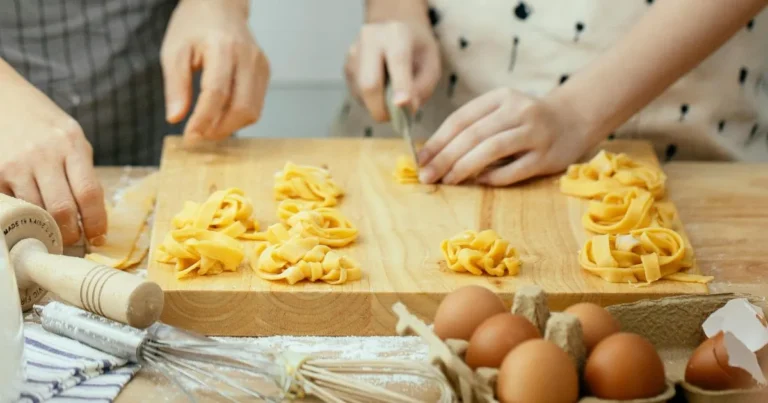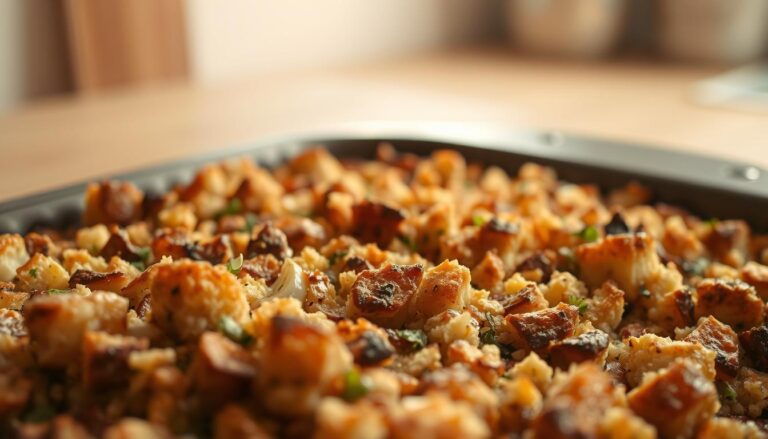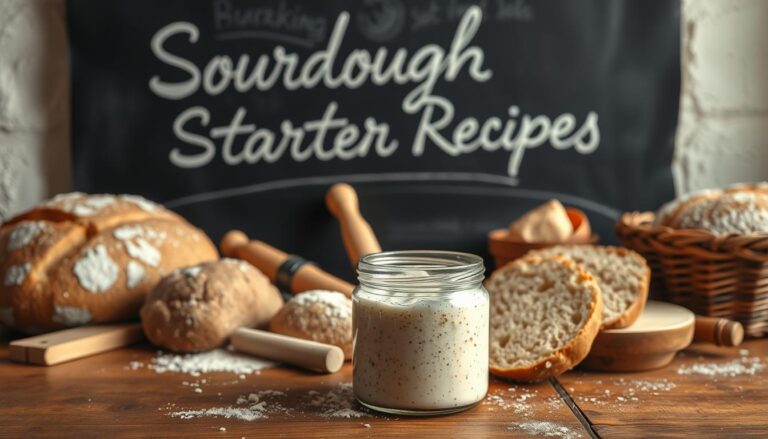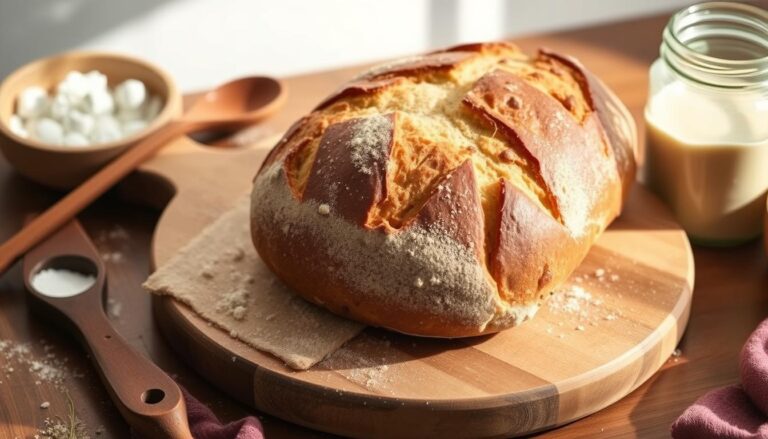What are sourdough cinnamon rolls?
Table of Contents
What are sourdough cinnamon rolls?
Sourdough cinnamon rolls are a tasty twist on the classic breakfast pastry. They have a tangy flavor from natural fermentation. Your sourdough cinnamon rolls recipe turns a simple sweet treat into a gourmet breakfast.
The magic of sourdough cinnamon rolls is in their unique making. They use a living starter culture instead of commercial yeast. This creates rich, nuanced flavors and a more digestible, nutritious pastry.
When you eat a sourdough cinnamon roll, you’ll taste a unique tanginess. The outside is crisp, while the inside is soft and swirled with cinnamon and sweet filling. These rolls are more than breakfast – they’re a culinary journey.
Key Takeaways
- Sourdough cinnamon rolls use natural fermentation for deeper flavor
- They offer a more complex taste profile compared to traditional rolls
- The fermentation process improves digestibility
- Natural starter creates a unique tanginess
- These rolls represent an artisanal approach to a classic breakfast treat
Understanding Sourdough Cinnamon Rolls
Sourdough cinnamon rolls are a tasty twist on the classic breakfast treat. They mix traditional baking with unique flavors. These rolls turn a simple pastry into a special treat that’s good for you and tastes great.
The Science Behind Sourdough Fermentation
Sourdough fermentation makes these rolls special. Wild yeasts and good bacteria create a unique flavor mix. They break down flour proteins, making the rolls easier to digest and giving them a tangy taste.
- Wild yeast naturally present in flour
- Lactic acid bacteria contributing to flavor
- Extended fermentation process
How Sourdough Differs from Regular Yeast Rolls
Sourdough cinnamon rolls have a richer taste and texture than regular yeast rolls. The natural fermentation makes them taste deeper and more complex. Using leftover sourdough starter in discard cinnamon rolls also adds flavor and reduces waste.
| Characteristic | Sourdough Rolls | Commercial Yeast Rolls |
|---|---|---|
| Fermentation Time | 12-24 hours | 1-2 hours |
| Flavor Complexity | Rich, tangy | Neutral |
| Digestibility | Easier to digest | Standard |
Benefits of Natural Fermentation
Natural fermentation has many benefits for sourdough cinnamon rolls. It makes nutrients more available, helps with gluten sensitivity, and makes eating more enjoyable. Bakers can make delicious discard cinnamon rolls that are also good for your digestion.
- Enhanced nutrient absorption
- Lower glycemic response
- Improved flavor development
The History and Origins of Sourdough Baking
Sourdough baking has been around for thousands of years. It started long before we had commercial yeast. People back then found out that flour and water could turn into something amazing through natural fermentation. This is how sourdough cinnamon rolls came to be.
Studies show that sourdough started in Egypt around 1500 BCE. Bakers found out that wild yeasts and bacteria could make bread rise. This led to the sourdough cinnamon rolls we love today.
- Ancient Egyptian bakers first documented natural fermentation methods
- Greek and Roman cultures refined sourdough bread-making techniques
- European bakers brought sourdough traditions to North America during colonization
Every culture had its own sourdough way, based on what they had and the weather. San Francisco is famous for its sourdough bread. It has a special flavor that has made it loved all over the world.
| Region | Sourdough Characteristic | Cultural Significance |
|---|---|---|
| Egypt | First recorded natural fermentation | Foundational bread-making technique |
| Europe | Diverse regional sourdough styles | Culinary innovation |
| San Francisco | Unique tangy sourdough flavor | Regional bread identity |
Today, bakers still honor these old sourdough ways. They make sourdough cinnamon rolls that are full of flavor. Knowing the history behind these treats makes every bite even more special.
Essential Ingredients for Perfect Sourdough Cinnamon Rolls
Making sourdough cinnamon rolls is all about the right ingredients. They turn a simple recipe into a true masterpiece. Choosing top-notch ingredients is key to a great baking experience.
The Role of Active Starter
An active sourdough starter is crucial for your cinnamon rolls. It adds flavor and makes the dough light and airy. Your starter should be bubbly, recently fed, and at peak activity for the best results.
Flour Selection and Quality
Flour matters a lot in sourdough baking. Here are some important types:
- Bread flour (high protein for better structure)
- All-purpose flour (versatile and easy to find)
- Whole wheat flour (adds nutty taste and health benefits)
The protein in flour affects your rolls’ texture. So, pick the right one.
Additional Components for the Perfect Fill
Some extra ingredients make your cinnamon rolls special:
- High-quality ground cinnamon
- Soft butter for the filling
- Brown sugar for sweet caramel flavor
- Vanilla extract for extra taste
“The secret to extraordinary sourdough cinnamon rolls lies in the quality of your ingredients and the love you put into each step.”
By choosing and mixing these ingredients well, you’ll make sourdough cinnamon rolls that are both tasty and unforgettable.
Making Your Own Sourdough Starter for Cinnamon Rolls
Creating a sourdough starter is the first step to making delicious sourdough cinnamon rolls. This living mixture of flour and water becomes a powerful natural leavening agent. It transforms your baking. The process might seem intimidating, but with patience and consistent care, you’ll develop a robust starter. This starter brings incredible flavor to your rolls.
To begin your sourdough journey, you’ll need just two simple ingredients:
- Unbleached all-purpose flour
- Filtered water
Your starter requires a consistent feeding schedule to remain active and healthy. During the first week, you’ll discard half of the starter and maintain a small portion. This process helps develop the wild yeast and bacteria. These elements give sourdough its unique characteristics.
| Day | Feeding Routine | Expected Activity |
|---|---|---|
| 1-3 | Mix equal parts flour and water | Minimal bubbling |
| 4-7 | Discard half, feed with fresh flour | Increasing fermentation |
| 8-14 | Regular daily feedings | Active and ready to use |
Watch for key signs that your sourdough starter is ready: consistent bubbling, a pleasant sour aroma, and the ability to double in size within 4-8 hours after feeding. These indicators mean your starter is mature enough to create tantalizing sourdough cinnamon rolls.
Pro tip: Keep your starter in a clear glass container so you can easily monitor its growth and activity. Room temperature between 70-80°F provides the ideal environment for fermentation.
Step-by-Step Preparation Process
Making perfect sourdough cinnamon rolls needs care and patience. This guide will show you how to make delicious overnight sourdough cinnamon rolls. They will surely impress anyone who tries them.
Mixing and Kneading Techniques
The first step in making great sourdough cinnamon rolls is mixing and kneading. Start by mixing your active sourdough starter with top-quality flour. This makes the dough smooth and elastic.
Kneading is key to making the dough light and airy. It builds the gluten structure. This is what gives the rolls their texture.
- Use a stand mixer with a dough hook for consistent kneading
- Knead until the dough becomes smooth and passes the windowpane test
- Allow the dough to rest periodically during the kneading process
Rolling and Filling Methods
Rolling and filling the dough is crucial for beautiful sourdough cinnamon rolls. Roll out the dough into a rectangle. Make sure it’s even all over.
- Spread softened butter evenly across the dough surface
- Sprinkle a generous layer of cinnamon and sugar mixture
- Roll the dough tightly to create perfect spiral swirls
Proofing Times and Temperature Guidelines
Proofing is key for flavor and texture in overnight sourdough cinnamon rolls. The temperature and time affect the final taste and texture.
- Room temperature proof: 2-4 hours at 70-75°F
- Cold fermentation: 8-12 hours in the refrigerator
- Final proof before baking: 1-2 hours at room temperature
“The secret to exceptional sourdough cinnamon rolls lies in understanding and respecting the fermentation process.”
Tips for Creating the Perfect Swirl and Texture
Creating perfect sourdough cinnamon rolls needs careful technique and detail. The secret to stunning rolls is in how you roll, cut, and arrange the dough.
Begin by making sure your dough is at the right temperature and consistency. A rested dough is easier to work with and makes more beautiful swirls.
- Roll the dough into a precise rectangle, keeping edges even
- Spread filling edge to edge for consistent flavor
- Use a sharp knife or bench scraper for clean cuts
- Space rolls slightly apart to allow proper rising
Temperature is key for the perfect texture. Warm environments make your rolls soft and pillowy inside, with a slight crisp outside.
| Technique | Result |
|---|---|
| Gentle Rolling | Prevents tough dough texture |
| Even Filling Distribution | Consistent flavor in every bite |
| Proper Proofing | Light, airy roll structure |
Pro bakers say patience is the secret to amazing sourdough cinnamon rolls. Let your rolls rise slowly. This develops complex flavors and creates those beautiful swirls that make homemade pastries special.
Overnight Fermentation Methods and Benefits
Overnight sourdough cinnamon rolls make baking easier and tastier. They develop deep flavors and are ready for you in the morning. This method needs little morning work.
Learning to ferment overnight is key to better baking. It lets you control temperature and time. This way, you can make rolls as good as those from a bakery at home.
Cold Fermentation Process
The cold fermentation method has important steps for great overnight sourdough cinnamon rolls:
- Prepare the dough completely before refrigeration
- Cover the rolls tightly to prevent moisture loss
- Store at consistent refrigeration temperatures
- Allow adequate slow fermentation time
Timing and Temperature Control
Keeping the right temperature is key for overnight fermentation. Your fridge should be between 36-40°F. This helps the dough ferment well.
| Fermentation Stage | Temperature Range | Expected Outcome |
|---|---|---|
| Initial Proofing | 68-72°F | Initial rise and flavor development |
| Cold Fermentation | 36-40°F | Flavor intensification and slow rise |
| Final Proofing | 70-75°F | Final volume expansion before baking |
For the best taste, take your rolls out of the fridge 1-2 hours before baking. This lets them finish rising at room temperature. They’ll be light and fluffy.
Creative Variations and Filling Options
Your sourdough cinnamon rolls recipe can be more than just traditional flavors. With a bit of creativity, you can turn these classic treats into something truly special. They will surely impress your family and friends.
Try something new by exploring different fillings. Go beyond the usual cinnamon-sugar mix. Here are some exciting options:
- Chocolate Lovers: Use dark chocolate ganache or Nutella instead of cinnamon filling
- Fruity Delights: Add raspberry preserves, apple compote, or caramelized bananas
- Nutty Textures: Mix in chopped pecans, walnuts, or almond slivers for crunch
- Spice Blends: Try cardamom, chai spice, or pumpkin pie seasoning
When making your own sourdough cinnamon rolls, think about glazes that match your filling. A cream cheese frosting is great with fruit, while a salted caramel glaze is perfect for nutty flavors.
The secret to amazing sourdough cinnamon rolls is finding the right balance. Keep the tangy sourdough base while experimenting with new flavors. Don’t be shy to try out your own unique twist on this favorite breakfast treat.
“Baking is an art, and sourdough cinnamon rolls are your delicious canvas.” – Professional Baker
Troubleshooting Common Issues
Baking sourdough cinnamon rolls can be tricky, even for experienced home bakers. Knowing how to fix common problems will help you make perfect treats every time.
Fixing Dense or Tough Rolls
Dense sourdough cinnamon rolls often come from a few issues. Here are some proven solutions:
- Make sure your sourdough starter is fully active before mixing
- Knead the dough well to develop the right gluten structure
- Give the dough enough time to proof at the right temperature
- Use high-protein bread flour for better rise and texture
Addressing Fermentation Problems
Fermentation is key for your discard cinnamon rolls. Watch for these critical signs:
| Fermentation Issue | Potential Cause | Solution |
|---|---|---|
| No rising | Inactive starter | Refresh starter before baking |
| Over-fermented dough | Too warm environment | Control proofing temperature |
| Weak gluten development | Insufficient kneading | Stretch and fold technique |
Proper Storage Solutions
Storing your sourdough cinnamon rolls right keeps them fresh and flavorful. Refrigerate them in an airtight container for up to 3 days. Or freeze for longer.
Every baking challenge is a chance to get better. With practice and patience, your sourdough cinnamon rolls will go from good to amazing.
Storing and Reheating Sourdough Cinnamon Rolls
Keeping your sourdough cinnamon rolls fresh is key. Enjoy them best in the first few days. But, with the right steps, you can make them last longer.
For short-term storage, keep them at room temperature. Use plastic wrap or an airtight container. They stay soft and flavorful for 2-3 days.
- Room temperature storage: 2-3 days
- Wrap in plastic or store in airtight container
- Keep away from direct sunlight
Freezing is great for longer storage. Wrap each roll in plastic, then in a freezer bag. They’ll stay tasty for up to a month.
| Storage Method | Duration | Best Practices |
|---|---|---|
| Room Temperature | 2-3 days | Airtight container, loose wrap |
| Freezer Storage | Up to 1 month | Plastic wrap, freezer bag |
Reheating needs gentle care. Use an oven or toaster oven at 300°F for 5-7 minutes. Pro tip: Add butter on top for extra moisture and flavor.
Thaw frozen rolls at room temperature for an hour before reheating. This helps them warm evenly and keeps their texture soft.
Conclusion
Making the perfect sourdough cinnamon rolls is an art. It mixes tradition, science, and creativity. You’ve learned about natural fermentation and how it turns simple ingredients into amazing treats. This knowledge can make your baking skills go from basic to advanced.
Using sourdough to make cinnamon rolls is a great way to reduce waste. Each batch lets you try new things and find your own baking style. It’s not just about following a recipe. It’s about understanding the mix of ingredients and how they ferment.
Getting good at sourdough takes time, practice, and a love for learning. Your baking journey is ongoing. Every roll you make is a chance to learn and grow. Don’t be afraid of mistakes and celebrate your successes.
Keep improving your baking skills. Remember, each sourdough cinnamon rolls recipe is a chance to show off your creativity. The knowledge you’ve gained will lead to many tasty adventures in your kitchen.
FAQ
What is a sourdough starter, and do I need one to make sourdough cinnamon rolls?
A sourdough starter is a mix of flour and water with wild yeast and bacteria. You don’t always need an active starter for cinnamon rolls. Sourdough discard can also make delicious rolls, making it great for home bakers.
How long does it take to make overnight sourdough cinnamon rolls?
Overnight sourdough cinnamon rolls need 8-12 hours of cold fermentation. The whole process, from start to finish, takes about 12-16 hours. Most of this time is spent waiting for the dough to ferment and rest.
Can I use sourdough discard in my cinnamon rolls recipe?
Yes, you can! Sourdough discard adds a tangy flavor to your rolls. It’s a great way to use up leftover starter and makes your rolls more interesting.
How do sourdough cinnamon rolls differ from traditional yeast rolls?
Sourdough cinnamon rolls taste more complex and slightly tangy. They might also be easier to digest than traditional yeast rolls. The fermentation process breaks down gluten, giving them a unique texture and flavor.
What type of flour works best for sourdough cinnamon rolls?
Bread flour is best for sourdough cinnamon rolls because it has more protein. This helps the dough develop a strong gluten structure. But, you can also use all-purpose flour or a mix for different tastes and textures.
How do I store homemade sourdough cinnamon rolls?
Store sourdough cinnamon rolls in an airtight container at room temperature for 2-3 days. For longer storage, freeze them for up to a month. Thaw at room temperature and warm in the oven for the best taste and texture.
Can I make sourdough cinnamon rolls without an active starter?
While a starter is traditional, you can use commercial yeast and sourdough discard as a substitute. However, the unique flavor and benefits of natural fermentation will be lessened.
What are some common troubleshooting tips for sourdough cinnamon rolls?
Make sure your starter is active and bubbly. Keep the dough at the right temperature during proofing. Avoid over-mixing and give the dough enough time to rest and rise. If your rolls are dense, it might mean your starter isn’t strong enough or the proofing conditions were off.








One Comment
Comments are closed.